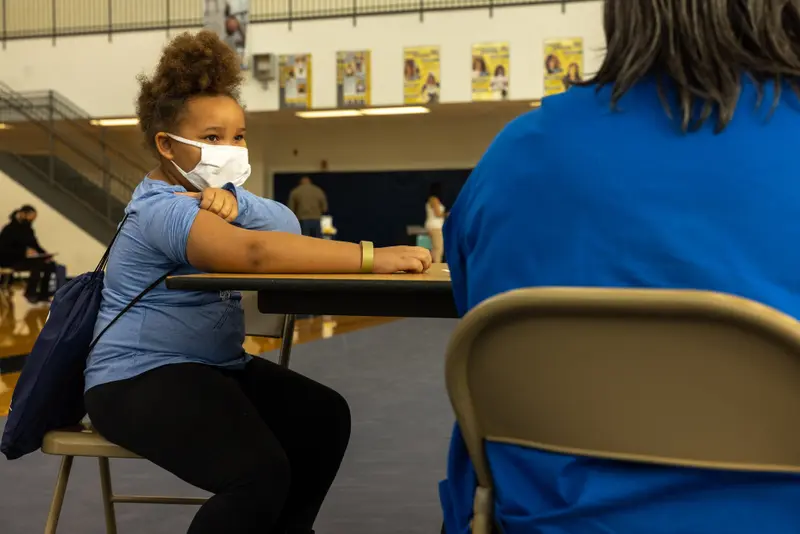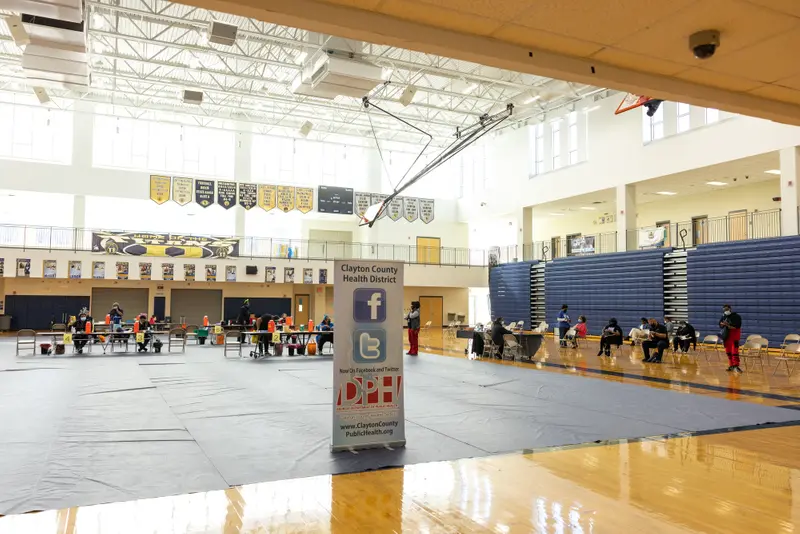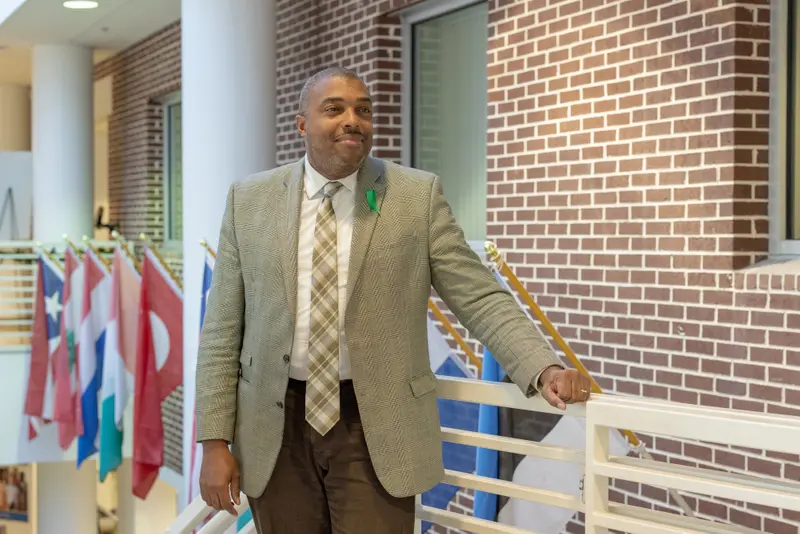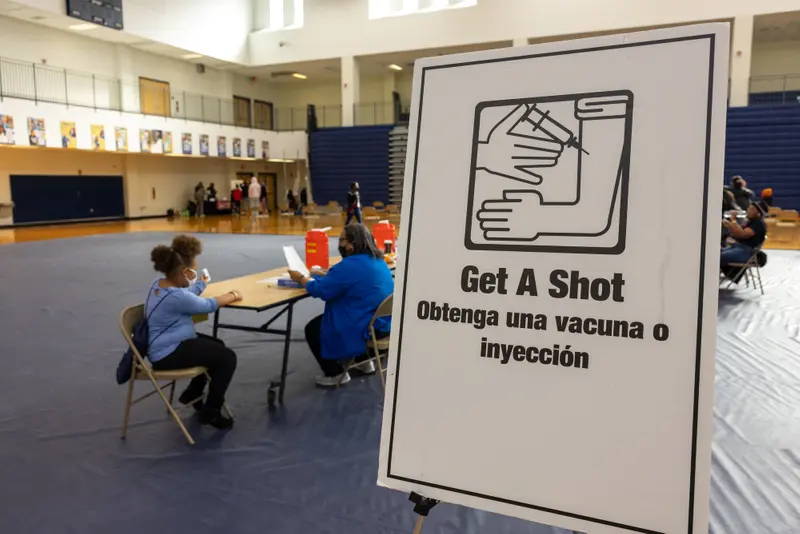Most people told her the COVID-19 vaccine helped them feel safer, but Barbara Hawkins worried it would make her sick.
Uninsured and without a regular doctor, she feared that side effects could aggravate her heart condition. Her friends and family, mostly vaccinated, reassured her that they wouldn’t.
Finally, on a Friday morning in late November, Hawkins drove two of her children to a vaccination event at a nearby high school. She sat in a metal chair in the gymnasium, under an array of years-old championship banners, where she and her 15-year-old and 6-year-old daughters rolled up their sleeves.
“It barely hurt,” 6-year-old Seaonna Phillips said, clutching the lollipop she’d been gifted.

Part of what convinced Hawkins to show up was the financial incentives offered by the organizers of the vaccine drive and two vendors at the event. Hawkins and her daughters each walked out of the building with $100 in gift cards.
But the event, meant to target vaccine-hesitant residents of Clayton County in south metro Atlanta, was not nearly the success that public health leaders had hoped. By the time staff began to break down tables and haul off the retractable banners pointing visitors in the correct direction, the department had distributed only 27 gift cards. They had budgeted for 300.
As Hawkins and her daughters got their shots, Carla Heath, business operations director of Clayton County’s health department, walked around the gym, her eyebrows furrowed above her mask. For weeks, she had done everything she could think of to promote the event, including sharing flyers through the health department and school district and asking a local radio station to make regular announcements. She had invited the library and local health nonprofits to set up informational tables in the high-ceilinged school hallway, hoping they would help spread the word leading up to the event.
And in what Heath considered the tour de force, the department had for the first time gotten permission to use state funding to offer $50 gift cards to every county resident who came in that day for a first or second dose. She figured people would appreciate some extra money for holiday shopping.
But to Heath’s dismay, the money wasn’t enough to overcome reluctance for a significant number of residents in Clayton County, where only 47% of people have received a single dose of the vaccine as of Dec. 3, according to the Georgia Department of Public Health’s vaccination dashboard. That’s 11 percentage points lower than the state average and 24 percentage points lower than the national one.
The disappointment she felt was typical among those trying to boost vaccination numbers in the county. A week earlier, a local nonprofit had held a vaccine clinic at a VFW post that ended with no veterans showing up to get vaccinated. In October, the county’s sole hospital, Southern Regional Medical Center, held several vaccine events that saw only a trickle of people, most of them related to hospital employees and seeking booster shots.
Clayton County, Georgia’s fifth largest county, dominated headlines last year for its role in turning Georgia blue in the 2020 presidential election. Its demographics flipped as white people moved away and more people of color arrived in the 1980s and ’90s; it now has the highest percentage of Black residents in the state and is home to several immigrant communities.
The county’s public health infrastructure is more strained than in other core counties in metro Atlanta — and the pandemic has made it worse. Moreover, county leaders have not taken some of the steps that those in other places have taken to convince a wary public to get vaccinated.
Local doctors and public health officials say Clayton County’s health infrastructure is more akin to that of a rural region than of a typical big-city suburb. It has one of the highest rates of people without insurance in a state that has not expanded Medicaid. It also has a severely low number of primary care doctors, dentists and mental health practitioners per capita.
The local health department, which is meant to serve on the front lines of the vaccine outreach, has much less funding per capita than neighboring metro Atlanta counties (less than half that of nearby Fulton, DeKalb and Cobb in 2021). The gap in funding is largely due to the department bringing in significantly less money in patient fees and donations than each of those other counties over the last four years, according to a ProPublica analysis. The department has struggled with infighting, staff turnover and declining patient numbers and has not had a permanent director since the middle of 2018.
Experts connect low vaccination rates in majority Black communities like Clayton County with widespread mistrust of government and medical institutions, borne from historic discrimination and ongoing health disparities disproportionately impacting residents.
“To the extent that there’s less investment in public health, there’s less providers and hospitals in a particular region, and that’s going to make individuals less likely to get accurate information and to be exposed to health care workers who might promote vaccinations to them,” said Timothy Callaghan, assistant professor at Texas A&M’s school of public health and a vaccine hesitancy expert.
As county leaders and public health experts in Clayton and beyond have learned, quick infusions of resources aren’t always enough to combat communities’ wariness. Amid fears of a winter spike in cases and the threat of the omicron variant, county leaders charged with convincing residents to overcome their fears are wondering: What now?
The delta variant spread aggressively in Clayton County from August to October, resulting in the highest numbers of cases and deaths per capita among the five biggest metro Atlanta counties. Clayton also experienced far more disruptions in its school system than neighboring counties this fall; during the first two months of the academic year, the district temporarily halted in-person learning for 19 schools, in large part because of the extent of the virus’s spread in the community.
But neither the dangerous arc of the virus nor the widespread school closures led to enough shots in arms to help Clayton catch up to neighboring counties’ vaccination rates. Parents are also moving slowly to get their young children vaccinated, with less than 3% of children age 5 to 9 vaccinated in the county compared to 8% statewide and 10% to 13% in metro Atlanta’s four larger counties.

Public health experts say that convincing the hesitant calls for more than just improved access to the vaccine. They also say the mere dissemination of accurate information about the vaccine isn’t enough to combat widespread skepticism of its safety. Other public health leaders have found that people are more likely to change their minds about getting vaccinated if they’re given accurate information and encouragement from someone they know and trust.
“We’ve certainly reached the point where the people who have yet to vaccinate are going to be the hardest people to convince to vaccinate,” Callaghan said. “We need to recognize that the messenger matters and not just the message.”
Looking around the sparsely populated hallway outside the gym in November, Heath appeared glum.
“I don’t know what else we could have done,” she conceded.
Heath first worked at Clayton’s health department for a few years in the 1990s. She returned in October 2019, an especially challenging time for the department — which got more challenging a few months later, when the coronavirus appeared in Georgia.
“I didn’t know what I was saying yes to,” Heath said.
Her job has been exceedingly difficult, as she has faced low revenue and staffing instability. The Thanksgiving long weekend was the first state holiday since the pandemic began when department employees were not expected to work.
One place people in Clayton County can go to get vaccinated is the county health department’s headquarters on Battle Creek Road, around the corner from the high school football stadium. A staging area for testing and immunization sits in tents outside the building.
The building itself closed in 2018, after several roof leaks. Officials found black mold in the building and shut it down for repairs and cleaning. It still hasn’t reopened to patients.
Most residents who use the services at Clayton County health department are uninsured, according to department reports. When the building closed, many would-be patients had to be directed to nearby counties for health services, if they went anywhere at all.
The department’s interim director at the time, Unini Odama, colorfully described the department as a “ship with medical cargo and crew looking for a port to perform services but unable to land and provide services for the survival of the community,” according to the minutes from an August 2018 county public health meeting.
Use of the department’s services has decreased significantly in recent years. In 2017, more than 10,000 people showed up for immunizations, while in 2020, just 2,400 people did. There were nearly 3,000 child health clinical visits in 2017, compared to just 750 in 2020. That dip has significantly reduced the amount of money the department brings in annually, impacting the department’s ability to hire staff and offer programs for the community.
“The relocation of our services has had a large impact on revenue,” Heath said. Months after the closure, an annex elsewhere in the county began offering immunizations, infectious disease testing, women’s health and other programs. But the annex building is much smaller and, due to social distancing requirements, can fit only a quarter as many people in its waiting room. The main facility reopened this year only for administrative staff, not for health programs. Health officials say the site will be fully revamped as a public health destination for residents, including a new pharmacy, private breastfeeding rooms for visiting parents and a sensory room for children with special needs — but the planned reopening date has been postponed.
The closure may also mean lost connections between residents and health professionals who could give information and advice about the COVID vaccine. “If you’ve lost physical space, if you end up losing people, you lose those relationships,” said Adriane Casalotti, public affairs chief at the National Association of County and City Health Officials. “It’s a lot harder to rebuild than just fixing a building.”
Before the pandemic, the department’s then-interim director told the staff that the state would be consolidating the administration of Clayton’s health department with that of a neighboring health district, according to an internal report prepared by the Georgia Department of Public Health in response to department employees’ workplace complaints. Heath and other employees said they have not been told when or whether that is still planned, hurting morale at an especially challenging and unstable time.
(Nancy Nydam, spokesperson for the Georgia Department of Public Health, did not answer questions about whether the districts would be consolidated in the future. She said in a written statement: “The Clayton County Board of Health has been and continues to operate as a stand-alone health district, under the direction of an interim health director.”)
As it tries to ramp up vaccine programs, the department is struggling to find qualified nurses to take necessary jobs, since its salaries are lower than those offered by private companies. In the county and across the country, staff turnover in local public health departments increased as a result of the pandemic, due in part to low pay and the stress of working the front lines.
Crystal Perry, who founded Melanated Pearl, a nonprofit that provides professional development for Black women, has followed the department’s setbacks and constant shifts in leadership. Uninsured, she avoided getting vaccinated for months, out of concern about potential side effects. But this August, her 70-year-old vaccinated aunt and 73-year-old unvaccinated uncle got sick with COVID-19. Her uncle’s hospitalization convinced her to get her first dose of the vaccine in late August, on the day before he died.
Perry does not use the health department for medical services. “I will say, I don’t feel like I would go there. In the midst of a health crisis, our health center is not seen as a hub for health,” she said.
Clayton County will receive $66 million in federal COVID-19 funding over the next few years for public health support, housing relief and economic help. But county commissioners approved an initial spending plan in August that included no additional funding for the local health department and very little specifically for vaccine outreach or education. The plan did include $12 million in premium pay for frontline workers, $3 million for hospital staff retention and hiring and $5 million in small business grants to offset the pandemic’s economic impact.
Jeff Turner, who chairs the county commission and sits on the public health board, said the local health department did not submit an application to receive funding, unlike organizations such as the hospital and local department of mental health. (The health department did not respond to a question about why it didn’t apply for the funding.) He acknowledged the problems with the health department’s staffing, its lack of primary care providers and the long-closed building, but said those can’t be blamed for the county’s low vaccination rate.
“The hesitancy comes from misinformation,” he said.
In a spring survey of residents conducted by Clayton County’s health department, people said their top reasons for not getting vaccinated included concerns about side effects, the short amount of time it took to create the vaccines and the lack of trust in sources to give them accurate information.
In response, county commissioners have held town hall meetings and other events to provide accurate information about the COVID-19 vaccine, and school officials have sent flyers home with children. Numerous sites across the county offer vaccinations, and officials publicize them through local groups such as churches and nonprofits. The health department sends teams to try to vaccinate homebound residents twice a week, has created mailers to attach to people’s water bills and holds vaccine clinics in the community. “I think we’ve done and touched every media there is in order to put out vaccination outreach,” Turner said, in response to questions about why so little of the $66 million was slotted for outreach and education.
Public health experts say it’s not surprising that efforts to better communicate public health messages to residents have been slow to take hold. The fallout of years of diminished public health services cannot be reversed overnight. But it’s crucial for the health departments like Clayton’s to find a way to reconnect with residents.
“The trust that can be built now with different parts of your community is something that can and really should be leveraged long-term, not just for COVID vaccinations, not just for the pandemic, but for all the public health needs and opportunities down the road,” Casalotti said.
Tiffani Hudson, an herbalist and mother of three children who attend Clayton’s public schools, does not see the benefit of the COVID vaccine. She has watched TV commercials where fast-talking lawyers recruit those sickened by botched medical treatments or devices, and she worries about herself or her children ending up among those clients. She doesn’t regularly get the flu shot and has her children on delayed vaccination schedules, sometimes turning down additional doses that doctors say are necessary for the strongest immune protection. “I’m not big on medicine, period,” she said.
Most of her information comes from other parents in her community who have children around the same age or older; she asks how their children responded to different vaccinations and medications to assess whether they are safe.
For Hudson, the existence of breakthrough cases — COVID infections in fully vaccinated people — is another reason to avoid the shot. “I am concerned about potential health hazards in the future with my children,” she said. “Also, the fact that it doesn’t stop us from getting COVID, the fact that they could still get it and still get very sick. It’s like, okay, so why am I chancing it with a fairly new unknown vaccine?”
But local public health numbers show just how much more likely unvaccinated people are to get infected: 90% of COVID-19 infections in Clayton County from late August to early October were among completely unvaccinated people. Just 7% were among fully vaccinated people. And from late August to early October, 97% of COVID-related deaths in Clayton County were among unvaccinated people.
Clayton County Public Schools superintendent Morcease Beasley knows that parents like Hudson are far from rare. Although cases in Clayton County have decreased from the late August peak, he said he will continue to push adults to get vaccinated and take their children to get their shots, too. If more families had been vaccinated, Beasley consistently points out, there would have been fewer outbreaks as the highly contagious delta variant swept across the county this fall — which would have meant fewer school closures.
Beasley is accustomed to leading through times of crisis. He began as superintendent in 2017 after Clayton’s school system, saddled with a dysfunctional school board, lost and then regained accreditation. Beasley was tasked by the board with improving the district’s morale and academics.

Beasley, supported by the school board, has been firm and vocal about safety mechanisms such as universal masking, offering vaccines and testing on campus and, as a last yet all too frequent resort, closing some schools to in-person learning.
The school district said this fall it spent about $700,000 of its general operating fund on vaccine education, a symptom checking program and contract tracers, which Beasley sees as an investment in being able to bring stability back to the schools. In addition, the district offered a $500 incentive for full-time employees and $250 for part-time employees to get COVID-19 shots, resulting in 73% of staff getting fully vaccinated this fall.
In a video hosted on YouTube in September, Beasley addressed caregivers’ concerns by fielding questions they posted in the chat and challenged families to take responsibility for their part in keeping cases down: “Let’s be very clear. Most of the students that are getting positive with COVID are catching COVID because they’re exposed to persons who are oftentimes unvaccinated.”
But he’s worried that, despite his efforts to spread his message, not enough people are listening.
This fall, Clayton County Public Schools suspended in-person instruction in more schools than the seven other core metro Atlanta districts combined; many districts didn’t close a single school. “The students are not necessarily getting exposed at school from staff,” Beasley said of Clayton County Public Schools. “They’re getting exposed from their family units.” Beasley said the closures were necessary because vaccination rates were low and the spread in the community was reaching dangerous levels. He also said he is confident the precautions the district took helped keep the county’s overall COVID numbers from being even worse.
But there’s only so much mitigation the district can do. According to Beasley, the cycle of disruption in the school system will continue until Clayton’s vaccination rate improves.
The county’s high case numbers also contributed to more parents choosing virtual learning, thwarting Beasley’s plan to have as many students as possible learning in person. In mid-August, nearly 6,000 students across the district were learning virtually, a number that grew to 8,600 by early December, out of 52,000 students enrolled in the district this fall.
Kira Suttles, who has both children and grandchildren in Clayton County schools, switched them to full-time virtual school after seeing cases in the county soar in the fifth week of fall classes. “I love my kids and I love them being at home,” Suttles said. “I’d rather deal with them than send them off to potentially get sick.”
As for what exactly would make her feel more confident about getting vaccinated, she isn’t sure. “With people still passing away that have the vaccine, it’s like, do I get it? Do I not get it? I’m just confused,” she said.
Two states west, Mississippi has received national recognition for being one of just 10 states where Black residents have a higher vaccination rate than white ones. Among Southern states, only Louisiana has a higher percentage of Black residents who’ve received a first shot. In Mississippi, more than half of Black residents — 53% — have gotten at least one dose, which exceeds the national average. In Clayton, only 40% of Black residents have received at least one dose.
In their effort to combat vaccine hesitancy, Mississippi health equity officials have trained barbers and hairstylists as community health advocates, partnered with historically black colleges and universities and given resources to community health centers to get more traction locally. As Chigozie Udemgba, the Mississippi health department’s director of health equity, puts it, the key has been “bringing vaccines to the community instead of standing outside the community and expecting people to show up.”
About 60 barbers and hairstylists statewide signed up to be health advocates with the federally backed “Shots at the Shop” initiative, he said. That number includes Damion Portis, owner of Klean Jokers Master Barber Arts Studio in Jackson, the state’s capital. Portis provided state-sponsored blood pressure screenings in his shop even before the pandemic began. After vaccinations became available, this approach evolved into a way to tackle vaccine hesitancy.
“I hear my people’s concerns. I hear their confusion. I hear the myths. I hear the misinformation as well as the good information,” Portis said at a media event explaining his work. “It’s not a vaccine-hesitation-shaming type of thing, but it’s about freely giving information to your clients that would benefit them and allowing them to make the choice that they choose.”
Heath continues to think about how Clayton County’s health department can boost vaccinations. When a ProPublica reporter told her about Mississippi’s barber health advocates, she expressed interest in trying that in Clayton. This summer, Clayton County’s health department received a $2 million, two-year federal health literacy grant, which is intended for COVID-related marketing, surveying and education efforts. According to the plan, the department will partner with community organizations to distribute information on COVID-19 protection and train medical professionals on how to communicate with patients. The department did not answer ProPublica’s questions on who exactly it will partner with and what work it has accomplished through this grant so far.
Lisa Diane White, a Clayton County resident who works in HIV prevention, knows the importance of individual relationships to change minds, especially in the absence of established health infrastructure. She’s firsthand proof that it can work.
When White had questions about the COVID-19 vaccine, she looked to Black women in science for the answers. She found an online seminar from Kizzmekia Corbett, the Black immunologist who developed the research behind the Moderna COVID-19 vaccine.
In early March, two months after watching the seminar, White got her first dose. Now, she is the trusted source for many of her family members and friends, pushing her sister and mother to register for vaccinations when she did.
“People are not getting good medical care. They may have not ever had a good history of medical care. And so you just don’t have this trusted source. You don’t have a family doctor from back in the day that understands the research or any of those things,” said White, who is also part of a team at Georgia State University investigating COVID testing attitudes among Black people in Atlanta.
“All of those things lead to hesitancy, reluctance and downright non-participation.”





